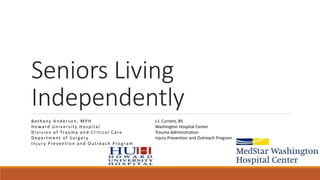
Seniors Living Independently Falls
- 1. Seniors Living Independently Bethany Anderson, MPH Howard University Hospital Division of Trauma and Critical Care Department of Surger y Injur y Prevention and Outreach Program J.J. Current, BS Washington Hospital Center Trauma Administration Injury Prevention and Outreach Program
- 3. Facts In the US, 1 in 3 older adults experience a fall each year. Falls are the leading cause of injury deaths among older adults. Falls are NOT normal. Falls are PREVENTABLE!
- 4. Living Independently Falls can be a major life-changing event that robs you of your independence. Fractures from falls, especially hip fractures, are a MAJOR source of loss of independence. Preventing falls are the key to living independently.
- 5. EDUCATION Do you know what puts you at risk? Does your family know what puts you at risk?
- 7. Risk Factors -- Biological Mobility issues Chronic health conditions Vision changes/vision loss
- 8. Risk Factors -- Behavioural Inactivity Medication – side effects and/or interaction Alcohol
- 9. Risk Factors -- Environmental Hazards in the home Incorrect size, type, or use of assistive devices Poorly designed public spaces
- 10. What Can YOU Do? GET ACTIVE! ◦ Strong muscles, good balance and a consistent exercise regimen can minimize your risk of falling
- 11. Exercise A regular exercise regimen of at least 30 minutes per day for at least 5 days per week Exercise Ideas: ◦ Tai Chi/Seated Tai Chi ◦ Walking ◦ Water Aerobics ◦ Strength Training Unconventional Exercise Ideas: ◦ Gardening
- 12. Exercise (continued) Stay Safe! ◦ Start with small amounts and gradually increase ◦ Move at your own pace ◦ Its OK to change or stop an activity ◦ Its OK to modify any exercise to protect your body ◦ When in doubt, talk to your doctor
- 14. What Can YOU Do? Medication Review and Management ◦ The more medications (prescription and over-the-counter) one takes, the more likely someone can fall. ◦ Talk with your doctor or pharmacists to identify and eliminate medication side effects and interactions.
- 15. What Can YOU Do? Vision Exams ◦ A proper vision exam and assessment can greatly reduce fall risks ◦ Talk to your primary care doctor and eye doctor about your eye prescription and any other vision issues
- 16. What Can YOU Do? Home Safety Assessment and Modification ◦ Environmental factors play a role in approximately half of all falls that occur in the home. ◦ A home safety assessment can identify factors that may put an individual at risk of falling. ◦ Things to check: ◦ Floors ◦ Stairs/steps ◦ Bedrooms ◦ Bathrooms ◦ Kitchens
- 17. How can you stay safe at home? American Trauma Society
- 18. Other Helpful Tips Wear shoes both inside and outside the home – avoid going barefoot or wearing slippers ◦ Choose lace-up/Velcro instead of slip-on shoes Get up slowly after you sit or lay down Keep emergency numbers on your fridge If you have a cell phone keep it on you at all times In areas of the home frequented the most, put a phone near the floor in case you fall and cannot get up
- 20. We want to hear from you! Questions? Comments? Concerns? Bethany Anderson, MPH Injury Prevention Coordinator Division of Trauma and Critical Care Department of Surgery 2041 Georgia Avenue, NW Suite 4B08 Washington, DC 20060 tel: (202) 865-7110 email: beanderson@huhosp.org J. J. Current, BS Trauma Prevention & Outreach Coordinator Trauma Administration jcurrent@medstar.net 110 Irving St., NW Room 4B-39 Washington, DC 20010 202-877-7153 PHONE 202-877-3173 FAX 202-748-7169 CELL www.MedStarWashington.org